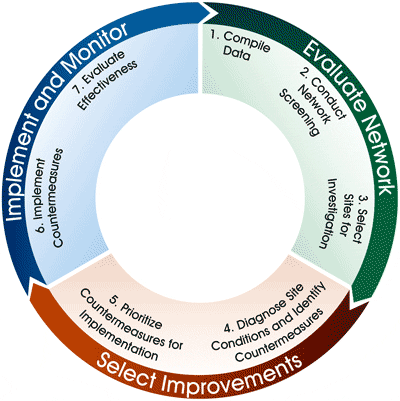The Federal Highway Administration (FHWA) Office of Safety created a Toolkit for Rural Local and Tribal Roadway Safety Practitioners (referred to hereafter as the Toolkit) to provide a step-by-step process to assist local agency and Tribal practitioners in completing traffic safety analyses. Figure 1 shows the safety process outlined in the Toolkit. The Toolkit includes an explanation of each step in the process and provides tools, examples, guidance, and resources for learning more about each step. The process and tools presented in the Toolkit are flexible and can be applied to assist in solving any number of safety situations.
The Toolkit has been developed to provide information about how to study road safety on rural roads under the jurisdiction of local or Tribal agencies. There are many different types of staff that could be responsible for safety on local and Tribal roads, including maintenance staff, landscapers, planners, engineers, or politicians. Throughout the Toolkit and User Guides, these people are referred to as “practitioners” or “staff,” independent of whether they work for a local or Tribal road agency. Similarly, the road agency is referred to as the “agency” or “jurisdiction,” whether it is a Tribal or local agency.
Figure 1. Toolkit Safety Analysis Process

What are the User Guides?
The FHWA has developed two User Guides (this document and its counterpart) to provide practitioners with examples of applying the tools presented in the Toolkit. Each User Guide presents an example scenario that is typical on rural roads and example solutions to the scenario using methods presented in the Toolkit.
The User Guides’ example scenarios show intended use and application of the tools for each toolkit process step. The User Guides’ example solutions provide step-by-step procedures for practitioners to apply the methods to comparable situations in any community.
There are two User Guides:
- User Guide #1 – Improving Safety on Rural Local and Tribal Roads – Site Safety Analysis describes a step-by-step analysis for conducting a site-specific safety analysis. This scenario is typical of a situation where a site of concern is identified by agency staff, an elected official or someone outside of the agency based on site crash history. User Guide #1 demonstrates Step 1 and Steps 4 through 7 in Figure 1.
- User Guide #2 – Improving Safety on Rural Local and Tribal Roads – Network Safety Analysis describes how to conduct a proactive analysis of a component of the transportation network such as all two-lane road segments, or all stop-controlled intersections. User Guide #2 demonstrates how to identify sites for safety improvement, diagnose conditions, implement selected countermeasures, and evaluate countermeasure effectiveness. User Guide #2 demonstrates all of the steps in Figure 1.
This is User Guide #1 – Site Safety Analysis. The example that follows demonstrates how to study conditions at a preselected site. In this hypothetical example, the study site has been identified from community concerns; however, the methods are applicable to any situation where one preselected site is under investigation.
Referring again to Figure 1, User Guide #1 provides example applications of:
- Step 1 – Compile Data;
- Step 4 – Diagnose Site Conditions and Identify Countermeasures;
- Step 5 – Prioritize Countermeasures for Implementation;
- Step 6 – Implement Countermeasures; and
- Step 7 – Evaluate Effectiveness of Implemented Countermeasures.
Steps 2 and 3 in this User Guide have already been completed because the site of interest was selected because of a public concern; not from a data-driven process.
